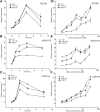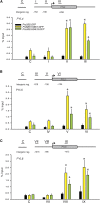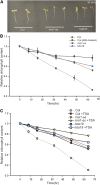The WD40 Domain Protein MSI1 Functions in a Histone Deacetylase Complex to Fine-Tune Abscisic Acid Signaling
- PMID: 26704384
- PMCID: PMC4746680
- DOI: 10.1105/tpc.15.00763
The WD40 Domain Protein MSI1 Functions in a Histone Deacetylase Complex to Fine-Tune Abscisic Acid Signaling
Abstract
MSI1 belongs to a family of histone binding WD40-repeat proteins. Arabidopsis thaliana contains five genes encoding MSI1-like proteins, but their functions in diverse chromatin-associated complexes are poorly understood. Here, we show that MSI1 is part of a histone deacetylase complex. We copurified HISTONE DEACETYLASE19 (HDA19) with MSI1 and transcriptional regulatory SIN3-like proteins and provide evidence that MSI1 and HDA19 associate into the same complex in vivo. These data suggest that MSI1, HDA19, and HISTONE DEACETYLATION COMPLEX1 protein form a core complex that can integrate various SIN3-like proteins. We found that reduction of MSI1 or HDA19 causes upregulation of abscisic acid (ABA) receptor genes and hypersensitivity of ABA-responsive genes. The MSI1-HDA19 complex fine-tunes ABA signaling by binding to the chromatin of ABA receptor genes and by maintaining low levels of acetylation of histone H3 at lysine 9, thereby affecting the expression levels of ABA receptor genes. Reduced MSI1 or HDA19 levels led to increased tolerance to salt stress corresponding to the increased ABA sensitivity of gene expression. Together, our results reveal the presence of an MSI1-HDA19 complex that fine-tunes ABA signaling in Arabidopsis.
© 2016 American Society of Plant Biologists. All rights reserved.
Figures







Similar articles
-
Role of histone deacetylases HDA6 and HDA19 in ABA and abiotic stress response.Plant Signal Behav. 2010 Oct;5(10):1318-20. doi: 10.4161/psb.5.10.13168. Epub 2010 Oct 1. Plant Signal Behav. 2010. PMID: 20930557 Free PMC article.
-
HD2C interacts with HDA6 and is involved in ABA and salt stress response in Arabidopsis.J Exp Bot. 2012 May;63(8):3297-306. doi: 10.1093/jxb/ers059. Epub 2012 Feb 24. J Exp Bot. 2012. PMID: 22368268 Free PMC article.
-
Molecular and physiological characterization of the Arabidopsis thaliana Oxidation-related Zinc Finger 2, a plasma membrane protein involved in ABA and salt stress response through the ABI2-mediated signaling pathway.Plant Cell Physiol. 2012 Jan;53(1):193-203. doi: 10.1093/pcp/pcr162. Epub 2011 Nov 24. Plant Cell Physiol. 2012. PMID: 22121246
-
Functions and mechanisms of plant histone deacetylases.Sci China Life Sci. 2020 Feb;63(2):206-216. doi: 10.1007/s11427-019-1587-x. Epub 2019 Dec 23. Sci China Life Sci. 2020. PMID: 31879846 Review.
-
The diverse and unanticipated roles of histone deacetylase 9 in coordinating plant development and environmental acclimation.J Exp Bot. 2020 Oct 22;71(20):6211-6225. doi: 10.1093/jxb/eraa335. J Exp Bot. 2020. PMID: 32687569 Free PMC article. Review.
Cited by
-
Molecular and epigenetic regulations and functions of the LAFL transcriptional regulators that control seed development.Plant Reprod. 2018 Sep;31(3):291-307. doi: 10.1007/s00497-018-0337-2. Epub 2018 May 24. Plant Reprod. 2018. PMID: 29797091 Review.
-
Epigenetic control of abiotic stress signaling in plants.Genes Genomics. 2022 Mar;44(3):267-278. doi: 10.1007/s13258-021-01163-3. Epub 2021 Sep 13. Genes Genomics. 2022. PMID: 34515950 Review.
-
Mechanisms of Plant Epigenetic Regulation in Response to Plant Stress: Recent Discoveries and Implications.Plants (Basel). 2024 Jan 7;13(2):163. doi: 10.3390/plants13020163. Plants (Basel). 2024. PMID: 38256717 Free PMC article. Review.
-
PcG Proteins MSI1 and BMI1 Function Upstream of miR156 to Regulate Aerial Tuber Formation in Potato.Plant Physiol. 2020 Jan;182(1):185-203. doi: 10.1104/pp.19.00416. Epub 2019 Aug 19. Plant Physiol. 2020. PMID: 31427464 Free PMC article.
-
Genome-wide Identification, Expression, and Functional Analysis of MdMSI Genes in Apples (Malus domestica Borkh.).Front Genet. 2022 Mar 3;13:846321. doi: 10.3389/fgene.2022.846321. eCollection 2022. Front Genet. 2022. PMID: 35309144 Free PMC article.
References
-
- Alexandre C., Möller-Steinbach Y., Schönrock N., Gruissem W., Hennig L. (2009). Arabidopsis MSI1 is required for negative regulation of the response to drought stress. Mol. Plant 2: 675–687. - PubMed
-
- Aufsatz W., Stoiber T., Rakic B., Naumann K. (2007). Arabidopsis histone deacetylase 6: a green link to RNA silencing. Oncogene 26: 5477–5488. - PubMed
-
- Ausín I., Alonso-Blanco C., Jarillo J.A., Ruiz-García L., Martínez-Zapater J.M. (2004). Regulation of flowering time by FVE, a retinoblastoma-associated protein. Nat. Genet. 36: 162–166. - PubMed
-
- Baker S.S., Wilhelm K.S., Thomashow M.F. (1994). The 5′-region of Arabidopsis thaliana cor15a has cis-acting elements that confer cold-, drought- and ABA-regulated gene expression. Plant Mol. Biol. 24: 701–713. - PubMed
Publication types
MeSH terms
Substances
LinkOut - more resources
Full Text Sources
Other Literature Sources
Molecular Biology Databases

